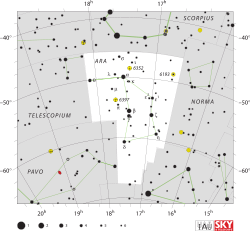Iota Arae

| |
| Observation data Epoch J2000 Equinox J2000 | |
|---|---|
| Constellation | Ara |
| Right ascension | 17h 23m 16.07715s[1] |
| Declination | –47° 28′ 05.5073″[1] |
| Apparent magnitude (V) | 5.245[2] |
| Characteristics | |
| Spectral type | B2 IIIne[3] |
| U−B color index | –0.82[4] |
| B−V color index | –0.11[4] |
| R−I color index | –0.08 |
| Variable type | BE[5] |
| Astrometry | |
| Radial velocity (Rv) | –19[6] km/s |
| Proper motion (μ) | RA: –4.35[1] mas/yr Dec.: –17.59[1] mas/yr |
| Parallax (π) | 3.49 ± 0.26[1] mas |
| Distance | 930 ± 70 ly (290 ± 20 pc) |
| Details | |
| Mass | 8.3 ± 0.4[7] M☉ |
| Luminosity (bolometric) | 5,740[8] L☉ |
| Surface gravity (log g) | 4.10[2] cgs |
| Temperature | 21,380[2] K |
| Rotational velocity (v sin i) | 375[9] km/s |
| Age | 30.0 ± 7.4[7] Myr |
| Other designations | |
Iota Arae (ι Ara, ι Arae) is the Bayer designation for a star in the southern constellation of Ara. It is approximately 930 light-years (290 parsecs)[1] from Earth, give or take a 70 light-year margin of error, and has an apparent visual magnitude of 5.25.[4] Based upon the Bortle Dark-Sky Scale, this means the star is visible to the naked eye from suburban skies.
This is an evolved giant star with a stellar classification of B2 IIIne.[3] The 'e' notation indicates the spectrum displays emission lines, which means this is a Be star that is surrounded by hot, circumstellar gas. It is spinning rapidly with a projected rotational velocity of 375 km/s.[9] The Doppler effect from this rotation is causing the absorption lines to widen and become nebulous, as indicated by the 'n' notation in the stellar class.
Iota Arae has around 8.3[7] times the mass of the Sun and is shining brightly with 5,740[8] times the Sun's luminosity. This energy is being radiated into space from the outer atmosphere at an effective temperature of 21,380 K,[2] giving it the characteristic blue-white hue of a B-type star.[11] It has been detected to vary in brightness by 0.054 in magnitude with no clear period.[12]
References
- 1 2 3 4 5 6 van Leeuwen, F. (November 2007), "Validation of the new Hipparcos reduction", Astronomy and Astrophysics, 474 (2): 653–664, arXiv:0708.1752
 , Bibcode:2007A&A...474..653V, doi:10.1051/0004-6361:20078357.
, Bibcode:2007A&A...474..653V, doi:10.1051/0004-6361:20078357. - 1 2 3 4 Soubiran, C.; Le Campion, J.-F.; Cayrel de Strobel, G.; Caillo, A. (June 2010), "The PASTEL catalogue of stellar parameters", Astronomy and Astrophysics, 515: A111, arXiv:1004.1069
 , Bibcode:2010A&A...515A.111S, doi:10.1051/0004-6361/201014247.
, Bibcode:2010A&A...515A.111S, doi:10.1051/0004-6361/201014247. - 1 2 Hiltner, W. A.; Garrison, R. F.; Schild, R. E. (July 1969), "MK Spectral Types for Bright Southern OB Stars", Astrophysical Journal, 157: 313, Bibcode:1969ApJ...157..313H, doi:10.1086/150069.
- 1 2 3 Kozok, J. R. (September 1985), "Photometric observations of emission B-stars in the southern Milky Way", Astronomy and Astrophysics Supplement Series, 61: 387–405, Bibcode:1985A&AS...61..387K.
- ↑ Samus, N. N.; Durlevich, O. V.; et al. (2009). "VizieR Online Data Catalog: General Catalogue of Variable Stars (Samus+ 2007-2013)". VizieR On-line Data Catalog: B/gcvs. Originally published in: 2009yCat....102025S. 1. Bibcode:2009yCat....102025S.
- ↑ Evans, D. S. (June 20–24, 1966), "The Revision of the General Catalogue of Radial Velocities", in Alan Henry, Batten; John Frederick, Heard, Determination of Radial Velocities and their Applications, Proceedings from IAU Symposium no. 30, University of Toronto: International Astronomical Union, Bibcode:1967IAUS...30...57E.
- 1 2 3 Tetzlaff, N.; Neuhäuser, R.; Hohle, M. M. (January 2011), "A catalogue of young runaway Hipparcos stars within 3 kpc from the Sun", Monthly Notices of the Royal Astronomical Society, 410 (1): 190–200, arXiv:1007.4883
 , Bibcode:2011MNRAS.410..190T, doi:10.1111/j.1365-2966.2010.17434.x.
, Bibcode:2011MNRAS.410..190T, doi:10.1111/j.1365-2966.2010.17434.x. - 1 2 Hohle, M. M.; Neuhäuser, R.; Schutz, B. F. (April 2010), "Masses and luminosities of O- and B-type stars and red supergiants", Astronomische Nachrichten, 331 (4): 349, arXiv:1003.2335
 , Bibcode:2010AN....331..349H, doi:10.1002/asna.200911355.
, Bibcode:2010AN....331..349H, doi:10.1002/asna.200911355. - 1 2 Bernacca, P. L.; Perinotto, M. (1970), "A catalogue of stellar rotational velocities", Contributi Osservatorio Astronomico di Padova in Asiago, 239 (1), Bibcode:1970CoAsi.239....1B.
- ↑ "iot Ara -- Be Star", SIMBAD Astronomical Database, Centre de Données astronomiques de Strasbourg, retrieved 2010-07-30.
- ↑ "The Colour of Stars", Australia Telescope, Outreach and Education, Commonwealth Scientific and Industrial Research Organisation, December 21, 2004, retrieved 2012-01-16
- ↑ Lefèvre, L.; et al. (November 2009), "A systematic study of variability among OB-stars based on HIPPARCOS photometry", Astronomy and Astrophysics, 507 (2): 11411201, Bibcode:2009A&A...507.1141L, doi:10.1051/0004-6361/200912304